Monthly Archives: September 2024

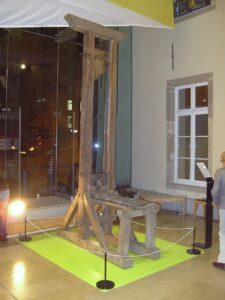 Death by guillotine…just the thought makes us cringe. Nevertheless, this form of the death sentence has been widely used throughout history, though not anymore. The last person to be executed by guillotine was Hamida Djandoubi, a Tunisian immigrant convicted of murder. He was executed at Baumetes Prison in Marseille, France. A guillotine is “an apparatus designed for efficiently carrying out executions by beheading. The device consists of a tall, upright frame with a weighted and angled blade suspended at the top. The condemned person is secured with a pillory at the bottom of the frame, holding the position of the neck directly below the blade. The blade is then released, swiftly and forcefully decapitating the victim with a single, clean pass; the head falls into a basket or other receptacle below.” While it might be a quick, clean, and efficient form of execution, it is one that brings thoughts of horror to most people.
Death by guillotine…just the thought makes us cringe. Nevertheless, this form of the death sentence has been widely used throughout history, though not anymore. The last person to be executed by guillotine was Hamida Djandoubi, a Tunisian immigrant convicted of murder. He was executed at Baumetes Prison in Marseille, France. A guillotine is “an apparatus designed for efficiently carrying out executions by beheading. The device consists of a tall, upright frame with a weighted and angled blade suspended at the top. The condemned person is secured with a pillory at the bottom of the frame, holding the position of the neck directly below the blade. The blade is then released, swiftly and forcefully decapitating the victim with a single, clean pass; the head falls into a basket or other receptacle below.” While it might be a quick, clean, and efficient form of execution, it is one that brings thoughts of horror to most people.
The guillotine first gained fame, when physician and revolutionary Joseph-Ignace Guillotin won passage of a law 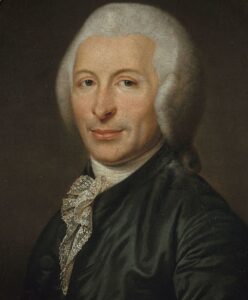 requiring all death sentences to be carried out by “means of a machine” during the French Revolution. This was not the first use of decapitating machines, however. They had been used earlier in Ireland and England. Guillotin and his supporters viewed these devices as more humane than other execution techniques, such as hanging or firing squad. I suppose I can see that, because both hangings and firing squad executions have gone wrong, and the guilty party suffered a prolonged period of agony before finally succumbing to their fate. To bring about a death that was more instantaneous, although not without agony…considering the moments before the blade dropped, the guillotine was brought into the mainstream of executions. A French decapitating machine was built and tested on cadavers. On April 25, 1792, a highwayman became the first person in Revolutionary France to be executed by this method.
requiring all death sentences to be carried out by “means of a machine” during the French Revolution. This was not the first use of decapitating machines, however. They had been used earlier in Ireland and England. Guillotin and his supporters viewed these devices as more humane than other execution techniques, such as hanging or firing squad. I suppose I can see that, because both hangings and firing squad executions have gone wrong, and the guilty party suffered a prolonged period of agony before finally succumbing to their fate. To bring about a death that was more instantaneous, although not without agony…considering the moments before the blade dropped, the guillotine was brought into the mainstream of executions. A French decapitating machine was built and tested on cadavers. On April 25, 1792, a highwayman became the first person in Revolutionary France to be executed by this method.
Though it was not originally named a “guillotine,” the device soon became known as such after its advocate, Joseph-Ignace Guillotin. Through the use of the device, more than 10,000 people lost their heads during the 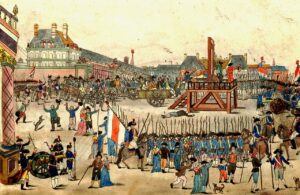
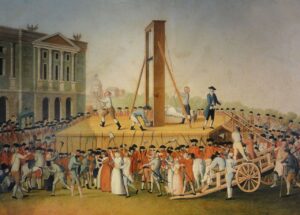 Revolution, including Louis XVI and Marie Antoinette, the former king and queen of France. France continued to us the guillotine during the 19th and 20th centuries, and incredibly, the last execution by guillotine occurred in 1977. Then, France outlawed capital punishment altogether in September 1981, and so the guillotine was abandoned forever. There is a museum dedicated to the guillotine in Liden, Sweden.
Revolution, including Louis XVI and Marie Antoinette, the former king and queen of France. France continued to us the guillotine during the 19th and 20th centuries, and incredibly, the last execution by guillotine occurred in 1977. Then, France outlawed capital punishment altogether in September 1981, and so the guillotine was abandoned forever. There is a museum dedicated to the guillotine in Liden, Sweden.

 My youngest grandson, Josh Petersen ended his 25th year of life by packing up his wife, Athena Petersen and their sons, Justin and Axel, and moving them to Lawton, Oklahoma. The day they left town was such a sad day for those of us left behind, and while it was also sad for them, they went with a sense of adventure too. I can’t blame them for feeling the excitement of the move, but of course, I am one of those left behind. For us, their parents, grandparents, siblings, niece and nephews, there is an empty space that now lives in our lives. Nevertheless, we will find creative ways to stay close to these loved ones too.
My youngest grandson, Josh Petersen ended his 25th year of life by packing up his wife, Athena Petersen and their sons, Justin and Axel, and moving them to Lawton, Oklahoma. The day they left town was such a sad day for those of us left behind, and while it was also sad for them, they went with a sense of adventure too. I can’t blame them for feeling the excitement of the move, but of course, I am one of those left behind. For us, their parents, grandparents, siblings, niece and nephews, there is an empty space that now lives in our lives. Nevertheless, we will find creative ways to stay close to these loved ones too.
Josh will begin his 26th year with a new job. He is still doing the same work he was in Casper…recharging fire 
 extinguishers, but now he will be working at Fire Pros, LLC in Lawton. This was a step up for him, as he is making five dollars more an hour than he was here in Casper. Josh has to improve himself, especially when he and Athina are expecting their third son at the end of January. He rather fell into this work and was trained well at All Out Fire in Casper, and his new employer saw the great value in having a pre-trained employee on staff. He jumped at the chance to hire Josh. Josh had wanted to be a firefighter when he went to college, but his knees would not allow him to do so. This is for him, the next best option. It may not always be what he wants to do, but I know that whatever he decides to do, he will excel at, because Josh is a hardworking man, who is very loyal to his employers. He always has been, and we are very proud of his work ethic.
extinguishers, but now he will be working at Fire Pros, LLC in Lawton. This was a step up for him, as he is making five dollars more an hour than he was here in Casper. Josh has to improve himself, especially when he and Athina are expecting their third son at the end of January. He rather fell into this work and was trained well at All Out Fire in Casper, and his new employer saw the great value in having a pre-trained employee on staff. He jumped at the chance to hire Josh. Josh had wanted to be a firefighter when he went to college, but his knees would not allow him to do so. This is for him, the next best option. It may not always be what he wants to do, but I know that whatever he decides to do, he will excel at, because Josh is a hardworking man, who is very loyal to his employers. He always has been, and we are very proud of his work ethic.
Josh is also a loyal family man and is always willing to sacrifice his needs to make sure his wife and sons have everything they need. Josh met Athena when they were in middle school, and as often happens, they didn’t 
 know that this was their forever love, until much later when they ended up working together. I think they knew the minute they found out they were working together, however. The rest is history, as they say. In short order they were married, had two sons, and have one on the way. They love taking the boys to the park, and other places of interest…and they take lots of pictures, which we will all treasure even more now. We want them to be happy, and their lives to be full, but as long as they live away from us, we will all miss them very much. Nevertheless, as they have said before, “Home is Wherever I’m With You” and so it is. Today is Josh’s 26th birthday. Happy birthday Josh!! Have a great day!! We love you!!
know that this was their forever love, until much later when they ended up working together. I think they knew the minute they found out they were working together, however. The rest is history, as they say. In short order they were married, had two sons, and have one on the way. They love taking the boys to the park, and other places of interest…and they take lots of pictures, which we will all treasure even more now. We want them to be happy, and their lives to be full, but as long as they live away from us, we will all miss them very much. Nevertheless, as they have said before, “Home is Wherever I’m With You” and so it is. Today is Josh’s 26th birthday. Happy birthday Josh!! Have a great day!! We love you!!

 Many factors go into the “make or break” status of a town. Sometimes, it’s all about location. Other times, it’s about what is built after the town is formed. Still other times, it’s about what is discovered there and how low its supply lasts. The town of Doaksville, Oklahoma was once the largest town in the Choctaw Nation. Doaksville was founded in the early 1820s when Josiah S Doaks and his brother established a trading post. It was a humble beginning that sprang from the anticipation of the arrival of the Choctaw Indians to the area after the signing of the Treaty of Doak’s Stand in October 1820. The brothers moved westward with their boats filled with goods for the trading post and headed up the Mississippi and Red Rivers. Soon, other settlers moved into the area to be close to the store for mutual protection.
Many factors go into the “make or break” status of a town. Sometimes, it’s all about location. Other times, it’s about what is built after the town is formed. Still other times, it’s about what is discovered there and how low its supply lasts. The town of Doaksville, Oklahoma was once the largest town in the Choctaw Nation. Doaksville was founded in the early 1820s when Josiah S Doaks and his brother established a trading post. It was a humble beginning that sprang from the anticipation of the arrival of the Choctaw Indians to the area after the signing of the Treaty of Doak’s Stand in October 1820. The brothers moved westward with their boats filled with goods for the trading post and headed up the Mississippi and Red Rivers. Soon, other settlers moved into the area to be close to the store for mutual protection.
There were raids from the Plains Indians, especially those from Texas, which necessitated the establishment in 1824, of nearby Fort Towson. With the establishment of the fort, Doaksville began to grow and had all the makings of becoming a permanent town. Roads were built, between Doaksville, the trading post, and Fort Towson to establish a supply line. Doaksville sat at the center of these crossroads, and Doaksville began to prosper from the Central National Road of Texas that ran from Dallas to the Red River before connecting with the Fort Towson Road, which went on to Fort Gibson and beyond to Fort Smith, Arkansas. Doaksville seemed to be right in the thick of things. In addition, steamboats on the Red River connected with New Orleans at a public landing just a few miles south of Doaksville, carrying supplies to Fort Towson and agriculture products out of the region. It looked like Doaksville was headed for greatness.
Then, in 1837, the Choctaw and the Chickasaw signed the Treaty of Doaksville, which allowed the Chickasaw to lease the westernmost portion of the Choctaw Nation for settlement. By 1840, Doaksville was really growing. It now sported five large merchandise stores, two of which were owned by Choctaw Indians and the others by licensed white traders. There was a harness and saddle shop, wagon yard, blacksmith shop, gristmill, hotel, council house, and church. A newspaper called the Choctaw Intelligencer…printed in both English and Choctaw.
Of course, with the settlement came the missionaries. A missionary named Alvin Goode described the settlement at the time, “The trading establishment of Josiah Doak and Vinson Brown Timms, an Irishman, had the contract to supply the Indians their rations, figured at 13 cents a ration. A motley crowd always assembled 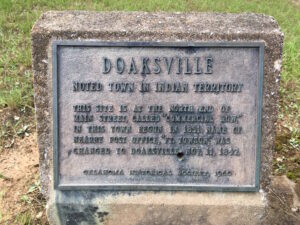 at Doaksville on annuity days to receive them. Some thousands of Indians were scattered over a nearly square mile tract around the pay house. There were cabins, tents, booths, stores, shanties, wagons, carts, campfires; white, red, black and mixed in every imaginable shade and proportion and dressed in every conceivable variety of style, from tasty American clothes to the wild costumes of the Indians; buying, selling, swapping, betting, shooting, strutting, talking, laughing, fiddling, eating, drinking, smoking, sleeping, seeing and being seen, all bundled together.”
at Doaksville on annuity days to receive them. Some thousands of Indians were scattered over a nearly square mile tract around the pay house. There were cabins, tents, booths, stores, shanties, wagons, carts, campfires; white, red, black and mixed in every imaginable shade and proportion and dressed in every conceivable variety of style, from tasty American clothes to the wild costumes of the Indians; buying, selling, swapping, betting, shooting, strutting, talking, laughing, fiddling, eating, drinking, smoking, sleeping, seeing and being seen, all bundled together.”
The town of Doaksville continued to grow, and in 1847 a post office was established. By 1850, the town had grown to more than thirty buildings, including stores, a jail, a school, a hotel, and two newspapers. Now established, it became the capital of the Choctaw Nation. For the next several years, Doaksville continued to thrive. Then, in 1854 Fort Towson was abandoned, and that spelled disaster for Doaksville. Without the business from the soldiers at the fort, Doaksville began to decline. Nevertheless, it would remain the tribal capital for the next nine years.
The Civil War, which broke out in 1861, spelled disaster for Doaksville. The region’s plantation-based economy was hit especially hard. In 1863, the Choctaw capital was moved to Chahta Tamaha, where it would remain until 1882, when it was moved for a third and final time to Tuskahoma, Oklahoma. The largest force in the Indian Territory was commanded by Confederate Brigadier General Stand Watie, chief of the Cherokee Nation. He was not one to admit defeat, and he would become the last Confederate general to surrender his command. When the leaders of the Confederate Indians learned that the government in Richmond, Virginia, had fallen and the Eastern armies had surrendered, most began making plans for surrender. The chiefs convened the Grand Council on June 15, 1865, and passed resolutions calling for Indian commanders to lay down their arms. Brigadier General Stand Watie refused until June 23, 1865, 75 days after Lee’s surrender in the East. At that point, he finally accepted the futility of continued resistance. He surrendered his battalion of Creek, Seminole, Cherokee, and Osage Indians to Lieutenant Colonel Asa C Matthews at Doaksville.
The collapse of the southern economy based on slave labor basically signed the death warrant Doaksville, and with the construction of the Saint Louis and San Francisco Railroad through the Southern Choctaw Nation in 1900-1901, its fate was sealed. At that time, the few buildings that remained at Doaksville were abandoned or moved to a new town that formed near the railroad, taking the name of the old post…Fort Towson. In 1903, the name of the Doaksville post office was changed to Fort Towson.
In 1960, the old town of Doaksville was acquired by the Oklahoma Historical Society. Little remained on the surface to betray its former importance, but in the 1990s, several archaeological excavations occurred, exposing the foundations of several buildings, including a jail, wells, a store, a hotel, and thousands of artifacts. 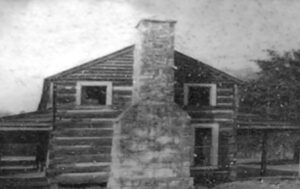
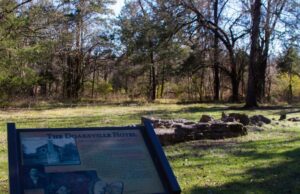 Today, a walking trail leads visitors through the site with interpretive signs telling the history of the old settlement. The old townsite has been designated as a National Historic Site, can be accessed through the Fort Towson Cemetery. A portion of the cemetery holds the burial sites of many important people who lived and died in Doaksville.
Today, a walking trail leads visitors through the site with interpretive signs telling the history of the old settlement. The old townsite has been designated as a National Historic Site, can be accessed through the Fort Towson Cemetery. A portion of the cemetery holds the burial sites of many important people who lived and died in Doaksville.
 On August 21, 1911, the Mona Lisa was stolen from the Louvre Museum in Paris, in what seemed like an impossible scenario. The theft of the Mona Lisa was called “art heist of the century,” but it was actually pretty basic. A small, mustached man entered the Louvre Museum in Paris, on the evening of Sunday, August 20, 1911, and made his way to the Salon Carré, where the Da Vinci painting was housed alongside several other masterworks. Maybe the museum didn’t think a theft could happen to them, it’s hard to say, but security in the museum was lax, so the man found it easy to stow away inside a storage closet. He remained hidden there until the following morning when the Louvre was closed, and there were few people around. He saw his chance to escape at around 7:15 am. He put on one of the white aprons worn by the museum’s employees. Then after checking to see if the coast was clear, he walked up to the Mona Lisa, took if off of the wall and carried it to a nearby service stairwell. There he removed it from the frame and tried to exit the stairwell into a courtyard. The door was locked, so he placed the Mona Lisa, which he had wrapped in a white sheet, on the floor and tried to take apart the doorknob. That got him nowhere, but an unsuspecting Louvre employee
On August 21, 1911, the Mona Lisa was stolen from the Louvre Museum in Paris, in what seemed like an impossible scenario. The theft of the Mona Lisa was called “art heist of the century,” but it was actually pretty basic. A small, mustached man entered the Louvre Museum in Paris, on the evening of Sunday, August 20, 1911, and made his way to the Salon Carré, where the Da Vinci painting was housed alongside several other masterworks. Maybe the museum didn’t think a theft could happen to them, it’s hard to say, but security in the museum was lax, so the man found it easy to stow away inside a storage closet. He remained hidden there until the following morning when the Louvre was closed, and there were few people around. He saw his chance to escape at around 7:15 am. He put on one of the white aprons worn by the museum’s employees. Then after checking to see if the coast was clear, he walked up to the Mona Lisa, took if off of the wall and carried it to a nearby service stairwell. There he removed it from the frame and tried to exit the stairwell into a courtyard. The door was locked, so he placed the Mona Lisa, which he had wrapped in a white sheet, on the floor and tried to take apart the doorknob. That got him nowhere, but an unsuspecting Louvre employee 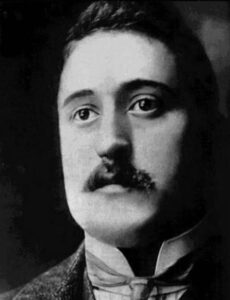 thought he was one of the Louvre’s plumbers, opened the door and let him out. He thanked the man and walked away.
thought he was one of the Louvre’s plumbers, opened the door and let him out. He thanked the man and walked away.
Then on September 7, 1911, came a shocking arrest. French poet Guillaume Apollinaire was jailed on suspicion of stealing Leonardo da Vinci’s Mona Lisa from the Louvre Museum in Paris. Apollinaire was a 31-year-old poet, who was known for his radical views and support for “extreme avant-garde” art movements, but his origins were shrouded in mystery. These days, it is believed that he was born in Rome and raised in Italy. At age 20, He moved to Paris and quickly blended in with the city’s bohemian crowd. His first volume of poetry, The Rotting Magician, appeared in 1909, followed by a story collection in 1910. Apollinaire was a supporter of Cubism, he published a book about the subject, Cubist Painters, in 1913. Cubism is “a revolutionary style of visual art invented by Pablo Picasso and Georges Braque in the early 20th century1. It is an influential modernist art movement that emerged in Paris, characterized by the transformation of objects and subjects 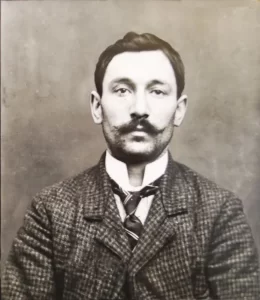 into geometric shapes, often resembling cubes or facets.” The same year, he published his most esteemed work, Alcools, where he used a variety of poetic forms and traditions to capture everyday street speech. His experimental play The Breasts of Tiresias was produced in 1917, for which he coined the term “surrealist.”
into geometric shapes, often resembling cubes or facets.” The same year, he published his most esteemed work, Alcools, where he used a variety of poetic forms and traditions to capture everyday street speech. His experimental play The Breasts of Tiresias was produced in 1917, for which he coined the term “surrealist.”
His poetic works were inspirational, but Apollinaire’s mysterious background and radical views led authorities to view him as a dangerous foreigner and therefore a prime suspect in the Mona Lisa heist. Still with all their searching, they could find no evidence that linked Apollinaire to the theft. Apollinaire was released after five days. It seemed that the Mona Lisa, which is today valued at about 1 billion dollars, was lost forever. Then two years later, a former employee of the Louvre, Vincenzo Peruggia, was arrested while trying to sell the famous painting to an art dealer. He had been the bold thief and Apollinaire had simply been wrongfully accused.
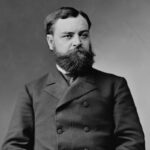
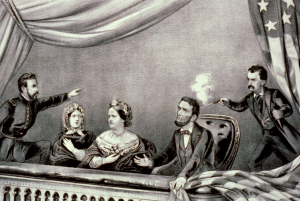 Whether Robert Lincoln’s presence at or near a presidential assassination had anything to do with bringing it to pass or not, is irrelevant…he began to think his presence was relevant. Robert Todd Lincoln was Abraham Lincoln’s son, and while he wasn’t present at his father’s assassination, he was close. He was at the White House, and upon hearing of the assassination, he rushed to be with his parents. The president was moved to the Petersen House after the shooting, where Robert attended his father’s deathbed…and so began a series of strange coincidences in which Robert Todd Lincoln was either present or nearby when three presidential assassinations occurred. It isn’t surprising that Robert Lincoln began to think that maybe he was a “jinx” or “bad luck” if he was at a presidential event, but of course that was not the case. It was just what he believed.
Whether Robert Lincoln’s presence at or near a presidential assassination had anything to do with bringing it to pass or not, is irrelevant…he began to think his presence was relevant. Robert Todd Lincoln was Abraham Lincoln’s son, and while he wasn’t present at his father’s assassination, he was close. He was at the White House, and upon hearing of the assassination, he rushed to be with his parents. The president was moved to the Petersen House after the shooting, where Robert attended his father’s deathbed…and so began a series of strange coincidences in which Robert Todd Lincoln was either present or nearby when three presidential assassinations occurred. It isn’t surprising that Robert Lincoln began to think that maybe he was a “jinx” or “bad luck” if he was at a presidential event, but of course that was not the case. It was just what he believed.
Robert was at the Sixth Street Train Station in Washington DC, at President James A Garfield’s invitation, when the President Garfield was shot by Charles J Guiteau on July 2, 1881. In fact, Robert was an eyewitness to the event. He was actually serving as Garfield’s Secretary of War at the time. President Garfield, the 20th president of the United States, was shot at the Baltimore and Potomac Railroad Station in Washington DC at 9:30 am on Saturday, July 2, 1881. He actually lived two and a half months before passing away in Elberon, New Jersey, on September 19, 1881.
Then, on September 6, 1901, at President William McKinley’s invitation, Robert Lincoln was at the Pan-American Exposition in Buffalo, New York. For Robert, it happened again. The president was shot by Leon Czolgosz and though Robert was not an eyewitness to the event, he was just outside the building where the shooting occurred. Robert Lincoln saw these coincidences, and it really began to bother him, even though there was 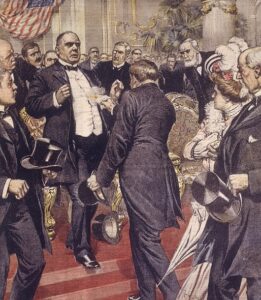
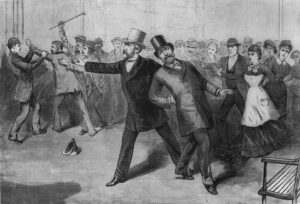 really no rational connection. The concern for Robert Lincoln was so great that he is said to have refused a later presidential invitation with the comment, “No, I’m not going, and they’d better not ask me, because there is a certain fatality about presidential functions when I am present.” While I don’t think his presence had anything to do with the assassinations, I think that Robert Lincoln suffered great distress from the things he witnessed or almost witnessed. That really must have been an absolutely horrible feeling for him.
really no rational connection. The concern for Robert Lincoln was so great that he is said to have refused a later presidential invitation with the comment, “No, I’m not going, and they’d better not ask me, because there is a certain fatality about presidential functions when I am present.” While I don’t think his presence had anything to do with the assassinations, I think that Robert Lincoln suffered great distress from the things he witnessed or almost witnessed. That really must have been an absolutely horrible feeling for him.

 Our aunt, Pearl Hein has spent much of her life taking care of others. She took care of her parents, husband, children, and grandchildren. She was also worked full time…plus. It seemed that the IGA in Forsyth, Montana where she lives, couldn’t function if Pearl wasn’t there. Eventually though, came the time for her to retire. I’m sure that IGA was sorry to see her go, but she was ready. After that, she took care of her husband, Uncle Eddie Hein until his passing in 2019. A short time later, in early 2020, her son, Larry Hein also passed away. This left Pearl feeling alone, even though, she has a daughter, Kim Arani living in Texas. For the most part, the loneliness was short lived. Where Pearl hadn’t really traveled much, she now made some trips to visit Kim, and I think she has really enjoyed that, and that makes me very happy. They looked like they had a great time.
Our aunt, Pearl Hein has spent much of her life taking care of others. She took care of her parents, husband, children, and grandchildren. She was also worked full time…plus. It seemed that the IGA in Forsyth, Montana where she lives, couldn’t function if Pearl wasn’t there. Eventually though, came the time for her to retire. I’m sure that IGA was sorry to see her go, but she was ready. After that, she took care of her husband, Uncle Eddie Hein until his passing in 2019. A short time later, in early 2020, her son, Larry Hein also passed away. This left Pearl feeling alone, even though, she has a daughter, Kim Arani living in Texas. For the most part, the loneliness was short lived. Where Pearl hadn’t really traveled much, she now made some trips to visit Kim, and I think she has really enjoyed that, and that makes me very happy. They looked like they had a great time.
Pearl is a kind and caring woman, and she is loved by many. Her humble nature tends to make her think less of 
 her own value though. I know that my family and my in-laws always loved Pearl and enjoyed spending time at her home. I only wish that she could have come to Casper more, but she always worked too hard, and didn’t often give herself the time off that she deserved. That always made me sad, because she really did deserve that time off. Pearl and Eddie always had a garden and she canned food from the garden to serve her family. Pearl was a great cook…I mean a really great cook. You never went away from her table hungry, and more likely you were too full, because you just couldn’t stop eating.
her own value though. I know that my family and my in-laws always loved Pearl and enjoyed spending time at her home. I only wish that she could have come to Casper more, but she always worked too hard, and didn’t often give herself the time off that she deserved. That always made me sad, because she really did deserve that time off. Pearl and Eddie always had a garden and she canned food from the garden to serve her family. Pearl was a great cook…I mean a really great cook. You never went away from her table hungry, and more likely you were too full, because you just couldn’t stop eating.
Pearl still lives in Forsyth, Montana, as do some of her grandchildren, and her siblings live nearby as well. I’m sure that is part of what keeps Pearl from moving to Texas to be nearer her daughter…that and maybe the
 Texas heat. I’m not sure, but some people like that heat and others really don’t. Still, she cand go visit in the cold winter months and at least enjoy not being in the “frozen tundra” of Montana. Ok maybe it really isn’t the frozen tundra, but it often feels that way in the coldest parts of Winter. It is my firm belief, that Pearl deserves whatever she wants to make her happy. She has spent so much of her life making others happy, healthy, and blessed. Now it is time for her to do things that make her happy. Today is Pearl’s 75th birthday. Happy birthday Pearl!! Have a great day!! We love you!!
Texas heat. I’m not sure, but some people like that heat and others really don’t. Still, she cand go visit in the cold winter months and at least enjoy not being in the “frozen tundra” of Montana. Ok maybe it really isn’t the frozen tundra, but it often feels that way in the coldest parts of Winter. It is my firm belief, that Pearl deserves whatever she wants to make her happy. She has spent so much of her life making others happy, healthy, and blessed. Now it is time for her to do things that make her happy. Today is Pearl’s 75th birthday. Happy birthday Pearl!! Have a great day!! We love you!!
 Fog delayed the departure of on September 4, 1963, but the delay was not able to save the plane or its passengers. Swissair Flight 306, a Sud Aviation SE-210 Caravelle III, named Schaffhausen, was scheduled to fly internationally from Zürich to Rome, with a stop in Geneva. Unfortunately, it crashed near Dürrenäsch, Aargau, shortly after take-off, killing all 80 people on board.
Fog delayed the departure of on September 4, 1963, but the delay was not able to save the plane or its passengers. Swissair Flight 306, a Sud Aviation SE-210 Caravelle III, named Schaffhausen, was scheduled to fly internationally from Zürich to Rome, with a stop in Geneva. Unfortunately, it crashed near Dürrenäsch, Aargau, shortly after take-off, killing all 80 people on board.
The plane was due to take off at 06:00 UTC, but the fog was throwing everything off. At 06:04 the flight was allowed to taxi to runway 34 behind an escorting vehicle, to await clearance. Then the crew of Swissair Flight 306, decided to taxi slowly down the runway at 06:05 to inspect the fog. Then they would return to the take off point. Part of the plan was to use high engine power in order to disperse the fog. It must have worked, because around 06:12 the Swissair Flight 306 returned to runway 34 and was allowed to take off. The flight took off at 6:13 and started to climb to flight level 150, which is about 15,000 feet, which would be its cruising altitude.
A short four minutes later, people on the ground witnessed a white trail of smoke coming from the left side of the aircraft. The white streak of smoke gave way to a long flame that erupted from the left wing. Around 06:20 the aircraft reached a height of about 8,900 feet. At that level, the plane began to descend and banking gently to the left before losing altitude more quickly and finally going into a steep and final dive. At 6:21 a frantic mayday message was issued. Then, at 6:22 the Swissair Flight 306 crashed into the ground on the outskirts of Dürrenäsch, approximately 22 miles from Zürich Airport.
So, what brought this plane down just minutes after takeoff. The taxi down the runway in an effort to clear the fog…believe it or not. When the plane went down the runway using full engine power, the pilot also applied the brakes so the plane wouldn’t try to take off. The brakes overheated, causing the magnesium wheels to burst. One of them burst on the runway prior to departure. Then, when the landing gear was retracted, the hydraulic lines in the gear bay were damaged, causing the hydraulic fluid to leak and ignite. The fire damaged the gear bay, and then the wing. Upon looking at the data from the airplane’s flight recorder, it was determined that the crew began experiencing difficulties at 6:18. The data became irregular beginning roughly two minutes later, 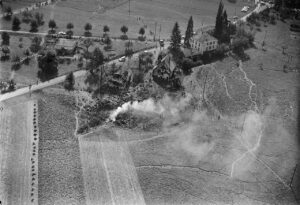 indicating that the fire was causing electrical problems. Analysis of the wreckage indicated that parts of the airplane began detaching “with increasing frequency” at about 6:18. The left engine had shut down prior to the crash, but it is uncertain whether this was from crew action, or a failure caused by the fire. The actual cause for the final loss of control was not conclusively determined, but it seems likely that loss of hydraulics played a key part in it. The rigidity of the left wing and rear fuselage, the integrity of the hydraulic flight control system, and the elevator control unit were all noted as possible areas the fire may have affected in the final portion of the flight to an extent which would have caused a rapid loss of control. In the end, all Caravelles were modified to use non-flammable hydraulic fluids, to avoid a recurrence of this tragedy.
indicating that the fire was causing electrical problems. Analysis of the wreckage indicated that parts of the airplane began detaching “with increasing frequency” at about 6:18. The left engine had shut down prior to the crash, but it is uncertain whether this was from crew action, or a failure caused by the fire. The actual cause for the final loss of control was not conclusively determined, but it seems likely that loss of hydraulics played a key part in it. The rigidity of the left wing and rear fuselage, the integrity of the hydraulic flight control system, and the elevator control unit were all noted as possible areas the fire may have affected in the final portion of the flight to an extent which would have caused a rapid loss of control. In the end, all Caravelles were modified to use non-flammable hydraulic fluids, to avoid a recurrence of this tragedy.

 My son-in-law, Kevin Petersen is a family-oriented guy who loves his kids and grandkids dearly. He and my daughter, Corrie Petersen have always been close to their kids. Like most parents, having a child move away is hard. When their son, Chris Petersen moved to Sheridan, Wyoming for college, it wasn’t that he had moved so far away, but rather that they could no longer see him every day. It’s never easy to have your child move away, and now with their son, Josh Petersen, his wife, Athena, and their sons, Justin and Axel (and their new son Cristian who is coming in January 2025) moving to Oklahoma, they are facing a new form of grief…that of being long-distance parents and grandparents. We all understand the move, but that doesn’t make it easy. Nevertheless, I know that Kevin and Corrie will find a way to make this work. Today’s technology will help some. They will call, facetime, video chat, text, and of course, visit…and it will be ok. Kevin and Corrie also have three grandchildren who still live here, and for that they are very grateful. Their son, Chris and his wife, Karen, have three kids, Cambree, Caysen, and Cyler.
My son-in-law, Kevin Petersen is a family-oriented guy who loves his kids and grandkids dearly. He and my daughter, Corrie Petersen have always been close to their kids. Like most parents, having a child move away is hard. When their son, Chris Petersen moved to Sheridan, Wyoming for college, it wasn’t that he had moved so far away, but rather that they could no longer see him every day. It’s never easy to have your child move away, and now with their son, Josh Petersen, his wife, Athena, and their sons, Justin and Axel (and their new son Cristian who is coming in January 2025) moving to Oklahoma, they are facing a new form of grief…that of being long-distance parents and grandparents. We all understand the move, but that doesn’t make it easy. Nevertheless, I know that Kevin and Corrie will find a way to make this work. Today’s technology will help some. They will call, facetime, video chat, text, and of course, visit…and it will be ok. Kevin and Corrie also have three grandchildren who still live here, and for that they are very grateful. Their son, Chris and his wife, Karen, have three kids, Cambree, Caysen, and Cyler. 

Kevin is an industrious guy, and he will also find ways to stay busy. He is currently working on his 1986 Chevy Monte Carlo right now, along with my husband, his father-in-law, Bob Schulenberg. They had to pull the engine out, finds the leaks it has, and repair them. For any who don’t know, pulling an engine is a huge job, and takes many hours. Nevertheless, these guys are experienced mechanics who have been doing this kind of work for years. When they get done with it, the Monte Carlo will be as good as new…the engine anyway. Kevin has done interior restoration and painting too, and it will eventually be showroom worthy.
Kevin is also very skilled at home renovation and has been making some changed to his and Corrie’s home. It isn’t done yet, but it really looks amazing. I have always been impressed with Kevin’s ability to restore, repair, renovate, and decorate the things they own. He really is an artist at heart, and his creativity is amazing. Kevin is also very creative in the kitchen. During Corrie’s time in nursing school, Kevin did all the cooking. He did 
 most of it before as well, because he is a trained chef, and very good at it. After Corrie had her gall bladder removed, meats because problematic for her, so she became a Lacto-ovo vegetarian, meaning she eats dairy and eggs, but not meats. Kevin embraced that in his cooking for her, even though he still eats meats. The meals he made were tasty, creative, and nutritious. He kept her going through those long school years, and continues to do so, not that she is a nurse. He has been a wonderful husband to our daughter, and we couldn’t ask for better. Today is Kevin’s birthday. Happy birthday Kevin!! Have a great day!! We love you!!
most of it before as well, because he is a trained chef, and very good at it. After Corrie had her gall bladder removed, meats because problematic for her, so she became a Lacto-ovo vegetarian, meaning she eats dairy and eggs, but not meats. Kevin embraced that in his cooking for her, even though he still eats meats. The meals he made were tasty, creative, and nutritious. He kept her going through those long school years, and continues to do so, not that she is a nurse. He has been a wonderful husband to our daughter, and we couldn’t ask for better. Today is Kevin’s birthday. Happy birthday Kevin!! Have a great day!! We love you!!
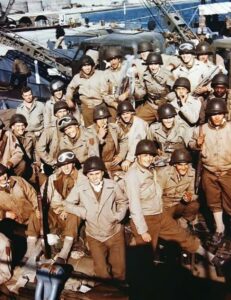
 Understandably, the size of the various armies has grown along with human civilization. It is estimated that nearly 28 million armed forces personnel stand at the ready globally in this present day, according to the London-based International Institute for Strategic Studies. Of course, peacetime armies would likely be smaller than wartime armies. World War II saw the most soldiers ever to be amassed…with about 70 million soldiers. Approximately 42 million of those soldiers were from the United States, the Soviet Union, Germany, and Japan. These nations armies and related services were four of the largest ever rallied to the battlefield. The largest three were the United States (12,209,000 troops in August 1945), the German Reich (12,070,000 troops in June 1944), and the Soviet Union (11,000,000 troops in June 1943). Those numbers are staggering to think about.
Understandably, the size of the various armies has grown along with human civilization. It is estimated that nearly 28 million armed forces personnel stand at the ready globally in this present day, according to the London-based International Institute for Strategic Studies. Of course, peacetime armies would likely be smaller than wartime armies. World War II saw the most soldiers ever to be amassed…with about 70 million soldiers. Approximately 42 million of those soldiers were from the United States, the Soviet Union, Germany, and Japan. These nations armies and related services were four of the largest ever rallied to the battlefield. The largest three were the United States (12,209,000 troops in August 1945), the German Reich (12,070,000 troops in June 1944), and the Soviet Union (11,000,000 troops in June 1943). Those numbers are staggering to think about.
As is expected in a world war, many soldiers are needed. So, the World War II army of the US became the biggest army in history. Citizens of the United States are notorious for patriotism, when we have been attacked. It is like waking a sleeping giant, and we will retaliate with a vengeance. Due in part to that surge of American patriotism and also because of conscription (the state-mandated enlistment of people in a national service, 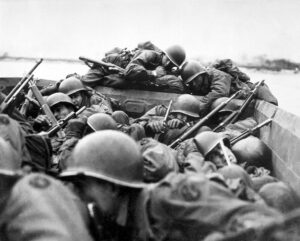
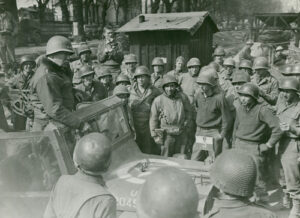 mainly a military service), the US Army numbered 12,209,000 soldiers by the end of the war in 1945. It is little surprise that the Japanese found themselves surrendering to the United States on this day, September 2, 1945. of course, the use of the atomic bombs on Hiroshima and Nagasaki, left little doubt that the Americans not only had the atomic bomb, but we would us it. Basically, their choices were to stay in the fight and die or surrender. They chose the latter, and the rest is history.
mainly a military service), the US Army numbered 12,209,000 soldiers by the end of the war in 1945. It is little surprise that the Japanese found themselves surrendering to the United States on this day, September 2, 1945. of course, the use of the atomic bombs on Hiroshima and Nagasaki, left little doubt that the Americans not only had the atomic bomb, but we would us it. Basically, their choices were to stay in the fight and die or surrender. They chose the latter, and the rest is history.
In order to determine which of the armies were the largest in history, 24/7 Wall Street reviewed a list of military superpowers from Business Insider. These armies were ranked based on the total number of troops that were serving a country or empire at the point when the army was at its largest. Without doubt, the United States was, and remains to this day, the nation with the largest army in history. Over the years, the armed forces of the United States have been larger and smaller, depending on the need at the time, the administration 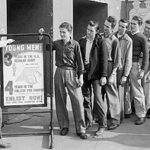
 in charge, and since the draft was discontinued, the number of people who chose to join up to serve their country and to qualify for the GI Bill so that they can get free college. No matter how they got in the service, or how long they stayed, I am very proud of all of our soldiers over the many years of this nation…and I thank them for their service. On this day, the largest army in history accepted the surrender of the Japanese, who had once had the nerve to attack us on our own soil. That was their biggest mistake ever.
in charge, and since the draft was discontinued, the number of people who chose to join up to serve their country and to qualify for the GI Bill so that they can get free college. No matter how they got in the service, or how long they stayed, I am very proud of all of our soldiers over the many years of this nation…and I thank them for their service. On this day, the largest army in history accepted the surrender of the Japanese, who had once had the nerve to attack us on our own soil. That was their biggest mistake ever.

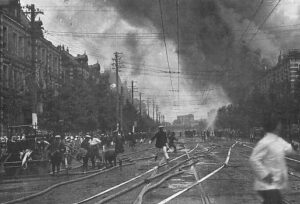 It was a typical lunch hour in Japan’s capital city of Tokyo, and the neighboring “City of Silk” Yokohama that September 1, 1923. People were out and about doing their normal lunchtime things, eating and running errands before going back to work. Suddenly the days routine was shattered when a massive, 7.9-magnitude earthquake struck just before noon. The shaking lasted just 14 seconds, but that was all it took to bring down nearly every building in Yokohama, which is just south of Tokyo. The shaking also caused more than half of Tokyo’s brick buildings, most of Yokohama’s buildings, and hundreds of thousands of homes to collapse, killing tens of thousands of people instantly.
It was a typical lunch hour in Japan’s capital city of Tokyo, and the neighboring “City of Silk” Yokohama that September 1, 1923. People were out and about doing their normal lunchtime things, eating and running errands before going back to work. Suddenly the days routine was shattered when a massive, 7.9-magnitude earthquake struck just before noon. The shaking lasted just 14 seconds, but that was all it took to bring down nearly every building in Yokohama, which is just south of Tokyo. The shaking also caused more than half of Tokyo’s brick buildings, most of Yokohama’s buildings, and hundreds of thousands of homes to collapse, killing tens of thousands of people instantly.
Known as the Great Kanto Earthquake, but also called the Tokyo-Yokohama Earthquake, of 1923, it caused an estimated death toll of more than 140,000 and left some 1.5 million people homeless, according to reported numbers. Following the earthquake came another disaster in the form of fires that burned many buildings. Most likely, this was because in 1923, people cooked over an open flame, and the quake struck while people were preparing lunch. To further complicate matters, the area was hit by high winds, caused by a typhoon that passed off the coast of the Noto Peninsula in northern Japan, spread the flames and created horrifying firestorms. Because the quake had snapped water mains, the fires could not be extinguished until September 3rd. By that time, about 45 percent of Tokyo had burned. Some researchers believed that the typhoon may have triggered the earthquake, because the forced atmospheric pressure pressed on a stressed and delicate fault line of three major tectonic plates that meet under Tokyo. I wasn’t aware that this was possible, but 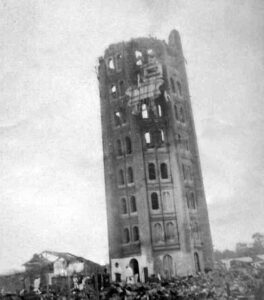 apparently it is. The quake also triggered a tsunami that swelled to 39.5 feet at Atami on the Sagami Gulf, where 60 people were killed and 155 homes destroyed.
apparently it is. The quake also triggered a tsunami that swelled to 39.5 feet at Atami on the Sagami Gulf, where 60 people were killed and 155 homes destroyed.
The damage from all this in Toyko was so severe that some government leaders argued for moving the Japanese capital to a new city. Educator, Miura Tosaku toured the destruction of Tokyo in the fall of 1923, concluded that the earthquake was an apocalyptic revelation. He wrote: “Disasters take away the falsehood and ostentation of human life and conspicuously expose the strengths and weaknesses of human society.” Tenrikyo relief worker Haruno Ki’ichi said, “The destruction and devastation in the earthquake aftermath surpassed imagination.”
Yokohama’s Victorian-era Grand Hotel, that had hosted famous people including US President William Howard Taft and English author Rudyard Kipling, completely collapsed. Hundreds of hotel employees and guests were crushed. Henry W Kinney, a Tokyo-based editor of the Trans-Pacific publication, observed the devastation in Yokohama hours after the earthquake hit. He wrote, “Yokohama, the city of almost half a million souls, had become a vast plain of fire, of red, devouring sheets of flame which played and flickered. Here and there a remnant of a building, a few shattered walls, stood up like rocks above the expanse of flame, unrecognizable … It was as if the very Earth were now burning. It presented exactly the aspect of a gigantic Christmas pudding over which the spirits were blazing, devouring nothing. For the city was gone.”
Since 1960, the Japanese people recognize the September 1 anniversary of the earthquake as Disaster Prevention Day. It’s a noble idea, but I’m not sure how these disasters could be prevented, other than the now common practice of earthquake proofing buildings to prevent so much loss. Nevertheless, Japan has suffered through several more devastating earthquakes. More than seven decades after the 1923 disaster, an earthquake struck Kobe on January 17, 1995. This Kobe Earthquake caused an estimated 6,400 deaths, widespread fires, and a landslide in Nishinomiya. Then, on March 11, 2011, a 9.0-magnitude temblor struck off th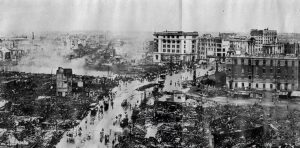
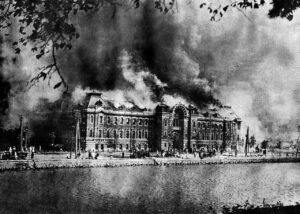 e coast of Japan’s city of Sendai. This Tohoku Earthquake and Tsunami caused a series of catastrophic tsunamis in Japan, and more than 18,000 estimated deaths. I suppose that to say the very least, the loss of life in these more recent quakes, was far less than in the original event that founded Disaster Prevent Day.
e coast of Japan’s city of Sendai. This Tohoku Earthquake and Tsunami caused a series of catastrophic tsunamis in Japan, and more than 18,000 estimated deaths. I suppose that to say the very least, the loss of life in these more recent quakes, was far less than in the original event that founded Disaster Prevent Day.

